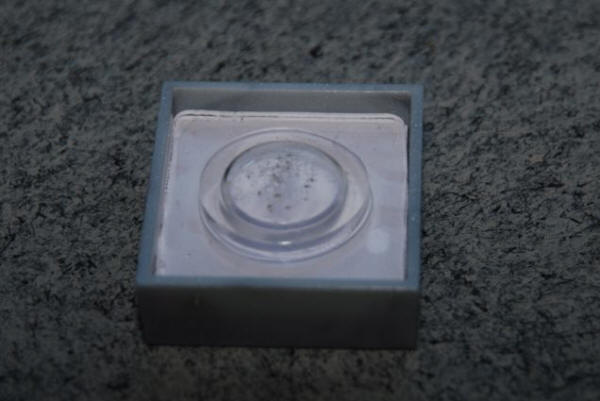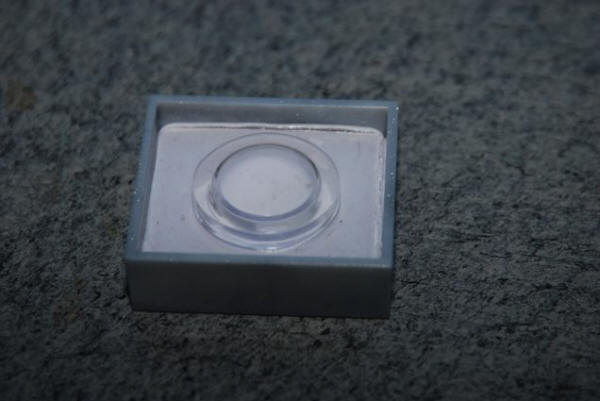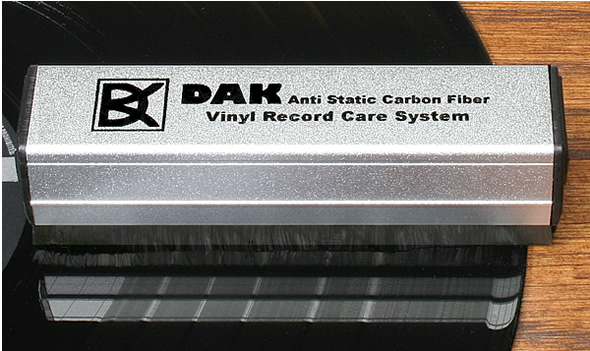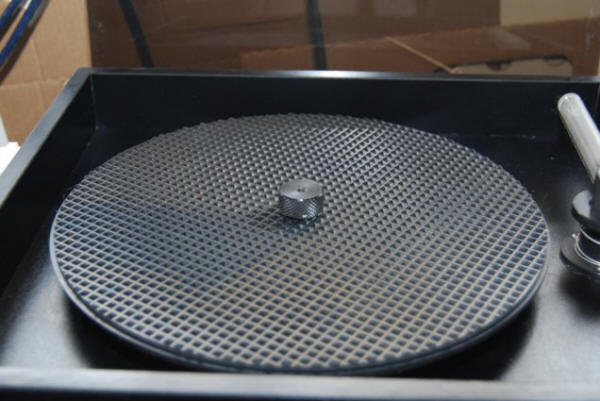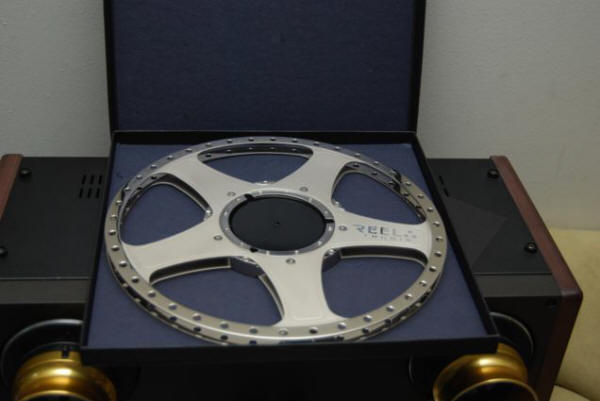|
You are reading the older HTML site
Positive Feedback ISSUE 62
A Quartet of Analog
Accessories
Oznow Stylus Cleaner Everybody's familiar with that old adage that seeing is believing. Nevertheless, the amount of black, vinyl crud that accumulates on a cartridge's stylus after but a single play is still absolutely mind boggling!
More to the point, the amount of vinyl debris removed by the Oznow Zerodust reinforces the notion that the stylus must be thoroughly cleaned after each and every play without fail for the best sound. Plus if not regularly removed, there's an increased likelihood that this plastic residue becomes forever burnished onto the stylus (for the record, my cleaning protocol involves cleaning with Oznow and very so often with Clearaudio's stylus cleaning fluid and bristle brush). So just as with LPs, cleanliness is next to godliness for cartridge styli. While far from a new product (I commented on it in the Home Entertainment Show Report 2005), the message about the Zerodust still hasn't, for some reason, reached the masses! The Zerodust's biggest advantage over the competition is that it's a "dry" cleaner and thus, there's no worry about chemicals in the cleaning fluid causing either damaging the glue bonding the stylus to the cantilever or migrating up the cantilever and affecting the cartridge's internal workings. For some unknown reason, there's a paucity of technical information available regarding this product but what little could be gleaned indicates that the Zerodust consists of a high tech, high viscosity, extremely soft, gel-like polymeric substance that "sucks" the crud off the stylus (probably in large part, the plasticizer that is on or has migrated to the surface of the LP). In fact, if you leave the Zerodust uncovered, you'll find it eventually covered in dust and dirt from the air! Plus the accompanying magnifying glass/cover is not only useful for checking for a dirty stylus but also for aligning cartridges. Cleaning the stylus with the Zerodust couldn't be any easier! All that's entailed is simply placing the device on the platter (taking care that the platter isn't spinning) and carefully lowering the stylus onto the absorbent gel (once you get the technique down, one literally "feels" the stylus stick). Allow the cartridge rest on the gel for a second or two and then lift the arm off the dome shaped plastic. More often than not, this process will reward you with a nice, big, black dot. My audiophile related OCD gets the best of me here and this procedure is repeated another two or three times to ensure a truly clean stylus. Once the gel starts to resemble a Dalmatian dog, a little soap and water will restore the Oznow to like new condition. (Though water alone worked quite well too).
A somewhat riskier method, seen a few times at audio shows, involves dabbing the stylus tip while the arm is locked down in the arm rest. This technique is far riskier, requires a very steady hand and all it takes is one slip up and kiss that cantilever bye-bye! Alternatively, some audiophiles have fashioned their own DIY stylus cleaner from a piece of dry, Magic Eraser. Indeed, I made my own DIY/ME by crazy gluing a small approximately 1 x 1 inch piece of the Magic Eraser to a nickel and used the same methods previously delineated to clean the stylus. In contrast to the Oznow, the Magic Eraser didn't accumulate the same small black dots, possibly indicating it's not cleaning quite as efficiently. Also it seemed that the stylus didn't always penetrate the top surface of the ME as consistently as the Oznow and thus needed more cleaning attempts. A must have accessory for all turntable owners! Available online at most high-end music stores or your local B&M shop. Price: $69. DAK Anti-Static Carbon Fiber Record Cleaning Brush How much in life seems to come down to a good news/bad new situation? The good news? I have three wonderful cats (two Bengals and one longhair rescue) that for the most part are jewels. The bad news? All three shed like crazy, especially Sweet Pea, my girl Bengal. The good news? Vinyl/analog is my preferred for musical reproduction. The bad news? LPs attract cat hairs like an electromagnets snap up cars at a junkyard. So short of getting rid of my kitties—and there's not a hope in hell of that happening—what's a pet loving audiophile to do?
Of course, owning a dedicated "wet" record cleaning machine is a no brainer whether one has pets or not! But what does a dyed in the wool vinyl lover do between regular disc washings? The easiest solution to this problem is using a record cleaning brush to whisk away those annoying cat hairs and debris on the record surface. But not all record brushes are created equal and after experimenting with several different brands on the market, the relatively inexpensive anti-static carbon fiber/velvet pad record cleaning brush from DAK has become my implement of choice. The DAK record brush uses a combination of two rows carbon fiber bristles coupled with and separated by a velvet pad. According to information posted on the DAK website, "the smaller diameter of carbon fiber bristles relative to human hair along with their thinness and strength allows bristles to better clean the LP" and "sweep out dust, dirt and micro-dust." To back up their claims, DAK includes several SEM pictures demonstrating the carbon fiber bristle reaching into bottom of record groove. (DAK's website also includes some interesting digital metallurgical microscope as well as SEM pictures of record grooves before and after cleansing.) The brush's velvet pad functions to pick up debris dislodged by the carbon fibers as well sitting on the surface of the record. The most efficient way to use the brush is to hold it flat on the spinning record to allow the front bristles and velvet pad to clean the grooves; just before picking the brush up, angle it slightly back so the rear row of bristles catch any schmutz left behind. My biggest issue with the brush was when it came to cleaning the velvet pad. Removing the debris as suggested with the Al holding bracket proved a mixed success; in the end, the best solution was cleaning the velvet pad with a soft toothbrush. Oh and while browsing the DAK website, take a few moments and take the "How Well Do You Know How Your Records Work" quiz! Price: $18.95 + shipping
Keith Monk's Pyr "Stay Clean" Record Cleaning Mat
Consider yourself extremely fortunate if you're blessed with a clean, pet-free listening environment. For the rest of us, it's a constant (and sometimes feels like losing) battle to keep those pesky pet hairs off records and out of the record inner sleeves. For instance, nothing is more frustrating to a dyed in the wool, neurotic audiophile than spending 10 or 15 minutes cleaning that precious reference disc with your favorite multi-step record cleaning process (and mine will be revealed shortly), flipping the record over to clean the opposite side and then finding the mat transferred dirt to the freshly cleaned first side! Drat! Foiled again. Why it's taken so long for someone to come up with a such a simple solution to this problem like Keith Monks' Tyr mat escapes me. With the Tyr mat, the LP essentially sits on a bed of nails; instead of nails, however, the record rests atop round bed of pyramid shaped cones fashioned from neoprene rubber. As a result, surface contact area between the record and offending mat is minimized, dirt and debris fall into the spaces between the pyramids, and the chances of a recontamination of that freshly cleaned album side is markedly reduced (of course over vacuuming and creating a static charge will increase the chance of attracting dirt). Plus the mat's softness and reduced contact lessens the chance of pushing the dirt deeper into the grooves when clamping the LP. Cleaning the mat if necessary with soap and water or just water is a snap. The only small hitch is that the thickness of the Monks mat doesn't leave much thread left to clamp the LP. But that's not an issue as long as one doesn't over tighten the nut with thin records and bow them. Price: $75
Reeltronix Take Up Reels As one whatsbestforum member (www.whatsbestforum.com ) recently remarked in the Reel-to-Reel Forum, "a take up reel (and supply reel) completely changes the look of a deck." Indeed it was this exact same thought that spurred Patrick Sinegal to custom design and manufacture his own high tech, mag wheel-like, reels. Sinegal aspired to design something "cool and different, industrial and old, something not typically found on eBay."
Patrick began building his reels as a hobby and later with a little nudging from Greg Beron of United Home Audio (who manufactures his own line of highly modified and customized, UHA/Tascam reel-to-reel decks), was persuaded to make his reels commercially available. No doubt that some audiophiles will gasp in shock at the Reeltronix's price ($375-395 each) but Patrick's reels are more than just another pretty face on the block. Besides, all it takes is a quick search on eBay to see what original rather industrial and pedestrian looking Technics reels command. And quite frankly those original Technics reels don't come close to the build quality of the Patrick's reels nor are they much cheaper either. The Reeltronix reels are available in a variety of finishes (with more promised) designed to match your deck (s) and hubs and include red and polished Al, and black and polished Al and polished and anodized blue reels (see Reeltronix website for pictures). (As we know, owning reel-to-reel decks is like eating Lays Potato Chips; you can't own just one!) The reel used for this review (with my Technics deck) was the polished nickel and matte nickel Reeltronix reel.
So what are a few of the differences between something like Jeff Jacob's J-corder Professional Precision Reels-Technics style and Patrick's Reeltronix reels? To start with, Patrick's Reeltronix reels are machined from sheets of domestic Aluminum rather than being stamped from Aluminum. Machining, as opposed to stamping, enhances the reel's stability and flatness but also makes them harder to mass produce. After handling one of Patrick's reels, all other reels feel flimsy by comparison. In the end Patrick's reels are far sturdier and really snap onto and lock down onto my Darklab NAB hub adaptor. Next, the Reeltronix packs tape far better than my J-corder Technics style reels and spins like a dynamically balanced car wheel. Then Patrick punches holes in the reel's rim in order to reduce the reel's total mass and consequently the strain on the deck's motors (and Technics machines used those big motors also used on their direct drive turntables). Finally, the Reeeltronix reels "openness" allows for easier viewing of the tape leader as well as leader between tracks.
Of course, the proverbial $64,000 question is does the Reeltronix take-up reel sound better than my stock J-Corder feed reel? While quick comparisons aren't practical, the Reeltronix reels sounded better than my J-corder/Technics reels in several important areas that may be linked to a reduction in the machine's wow and flutter. To begin with, there's a sizable increase in the solidity of images within the soundstage. Next, there's a feeling of more information, particularly in the midrange area. Finally, there's a greater sense of low frequency weight. A great addition to any reel-to-reel tape deck! Price: Depends upon finish.
|

